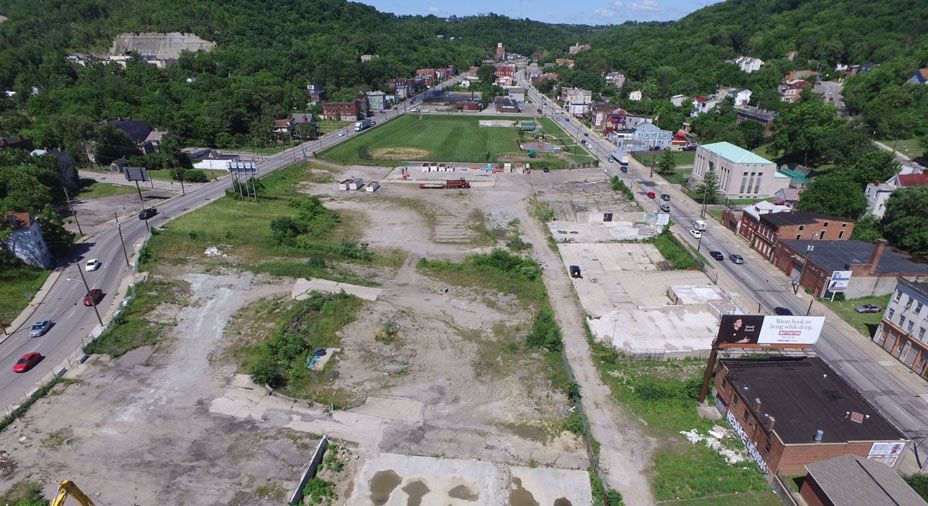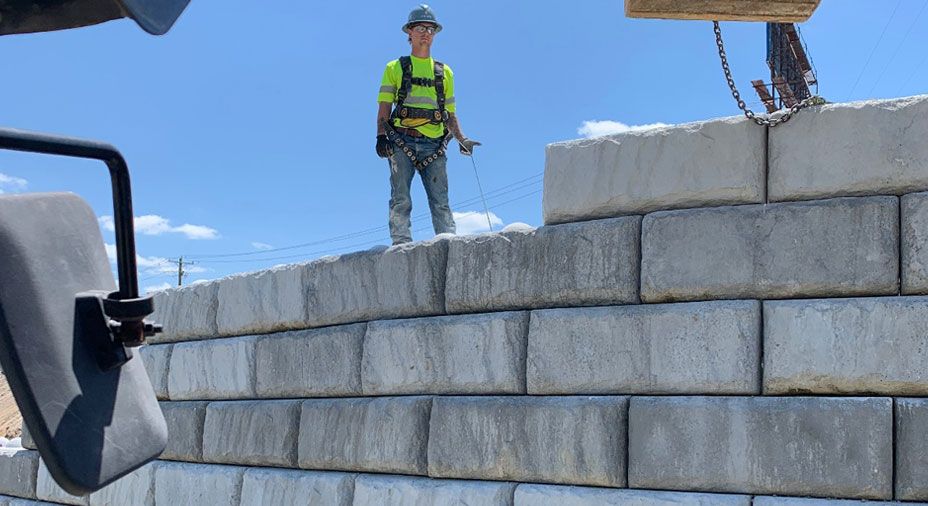During the 19th century, early settlers to Cincinnati, Ohio, followed the Lick Run valley and stream to settle in the developing city along the Ohio River. To control flooding in the area, the stream was enclosed in a 20-foot-diameter storm sewer in 1893. Soon after, during the advent of indoor plumbing, homes were tied into the system to then carry both rainwater and sewage.

The challenge
After a century of combined use and frequent sewage overflow into nearby Mill Creek during heavy rains, Cincinnati’s Metropolitan Sewer District (MSD) needed a solution for the valley’s worsening pollution crisis.
The massive transformation of the polluted and economically blighted area had to begin with the clearing and retention of the earth in today’s South Fairmont neighborhood between Westwood and Queen City Avenues.
The solution
In accordance with EPA demands to drastically reduce sewage overflow in the valley and throughout the greater Cincinnati area, MSD established a large-scale “green” solution called Project Groundwork in 2009. To address overflow reduction with environmentally, socially, and economically sustainable solutions, a 1.5-mile stretch of the valley would be transformed into both a functional urban waterway and a multi-use community recreational space called Lick Run Greenway.
Eleven Redi-Rock retaining walls were required to support the project’s new infrastructure and to avoid impact to the existing combined sewer, utilities, and roadways. Redi-Rock’s limestone texture was selected to blend seamlessly with the project’s natural elements.
The construction of the walls was completed in 2020 following the implementation of new storm sewers, stormwater detention basins, and bioswales. The once buried and contained Lick Run stream was resurfaced, in a process called, “daylighting”, as a mile-long constructed waterway through the Greenway. The project’s remaining infrastructure improvements included public recreation areas and gathering spaces, walkways, pedestrian bridges, lighting, and landscaping.
The design
Using Redi-Rock Wall+ Software (RRWall+), Justin Amlung, P.E. with Civil Solutions designed the project’s Redi-Rock retaining walls, most of which were needed to retain the earth along Westwood Avenue on Lick Run Greenway’s south border. The remaining Redi-Rock structures served as retaining walls to support grade changes within the greenway.
The gravity walls in the Lick Run project were designed to be constructed with Redi-Rock solid retaining wall blocks. Available in block widths of 28, 41, and 60 inches (710, 1030, and 1520 mm), these large wetcast blocks are like one-ton Lego blocks that interlock to build walls up to 15 ft (4.5 m) tall.
Amlung designed a single reinforced retaining wall against an existing roadway abutment using Redi-Rock’s Positive Connection (PC) Blocks for MSE walls. With space to excavate, the use of geogrid wrapped through the PC blocks increased durability and allowed for a taller wall height.
Redi-Rock 9-in (230-mm) step down units were used to address the gradual grade of the roadway abutting many of the Redi-Rock walls. The nine-inch blocks, at half the height of standard Redi-Rock blocks, helped ease the transitions at the top of the wall between blocks.
Josh Turton with block supplier Redi-Rock Structures of OKI noted that the step down also allowed the project to meet ODOT dimension requirements for the cast-in-place coping atop the walls. The retaining walls abutting roadways and waterways were topped with decorative metal guardrails, which added aesthetic appeal and safety measures, and also acted as barriers to restricted waterway areas.
Amlung explained the benefits of utilizing Redi-Rock for the retaining walls within the expansive project. “[The developer] put a premium on aesthetics and durability,” he said. “When you compare Redi-Rock to a small-block competitor in a water application, there really wasn’t much of a decision to be made.”
The installation
Dave Landwehr, project manager with Structures, Inc., Cincinnati, who led the installation crew, noted that the project involved numerous challenges like contending with changing traffic patterns along the construction site and tight work spaces between the roadway and new stream bed. The three-to-five-man wall construction team utilized an excavator, rubber tire loader, skid steers, and a conveyor belt truck to assist with their work.
The project team constructed a total of 28,000 square feet (2,601 sq m) of Redi-Rock gravity and reinforced retaining walls to complete this large-scale project spanning 1.5 miles (2.4 kilometers). Although the construction of the walls spanned over two years as the entire project progressed, the total work time occurred in about 30 days, averaging 900 square feet (83.6 sq m) of walls installed daily.

The outcome
At completion, project planners expected the Lick Run Greenway to cut about 400 million gallons of Combined Sewage Overflows (CSOs) per year. The public walkways and park areas are currently open for the public to enjoy.
The Lick Run Greenway was named by Storm Water Solutions (SWS) as one of only 10 2022 Top Project honorees across the country. The SWS Top Project awards program “highlights the best storm water and erosion control projects of the year that sought creative solutions.” The award recognized the transformation of a long-term wastewater problem into a sustainable multi-use solution, dramatically reducing harmful CSOs and providing swaths of usable greenspace in an urban environment.
The success of the Lick Run Greenway project has helped the MSD and the City of Cincinnati more confidently plan future sustainable infrastructure efforts to address environmental issues and continue the community’s economic revitalization.
 TEXTILES.ORG
TEXTILES.ORG


